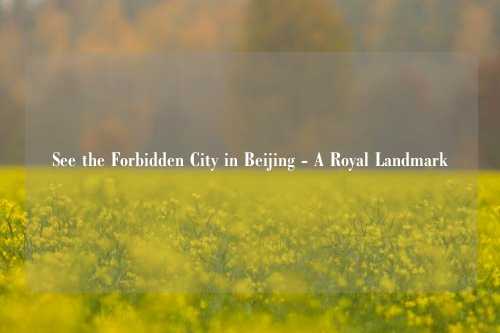See the Forbidden City in Beijing - A Royal Landmark
The Forbidden City: A Glimpse Into Imperial China
The Forbidden City, located in the heart of Beijing, is a vast palace complex that once served as the home to Chinese emperors and the administrative heart of the Chinese empire for over 500 years. Spanning over 72 hectares and containing 980 buildings, it is one of the largest and best-preserved palatial structures in the world. This architectural masterpiece is a symbol of imperial power, and its historical significance is paramount in understanding China's political and cultural evolution.
Once off-limits to the general public, the Forbidden City earned its name from the strict restrictions placed on entry. Only the imperial family, their court officials, and servants were allowed within its walls, making it a true symbol of exclusivity and power. Today, the Forbidden City is one of China’s most visited landmarks, attracting millions of tourists annually, who come to explore its stunning architecture, rich history, and magnificent art collections.

Architecture of the Forbidden City: A Symbol of Imperial Authority
The architecture of the Forbidden City is nothing short of breathtaking. It embodies the principles of traditional Chinese architecture, which emphasize harmony between man and nature, as well as balance and order. The layout is based on feng shui, with the main hall aligned on a north-south axis and the rest of the buildings organized symmetrically around it.
At the heart of the complex stands the Hall of Supreme Harmony, the largest and most important building. It was the site of major imperial ceremonies, such as the emperor’s coronation or the New Year celebrations. This hall is flanked by smaller structures, including the Hall of Central Harmony and the Hall of Preserving Harmony, which housed the emperor’s personal affairs and offered spaces for him to receive guests or conduct private meetings.
The Forbidden City is divided into two main areas: the Outer Court and the Inner Court. The Outer Court is where official government matters took place, and it includes the grand halls used for state ceremonies and meetings. The Inner Court was the residence of the emperor and his family, with living quarters, gardens, and areas for personal relaxation. The intricate courtyards, marble pathways, and decorative elements throughout the palace reflect the imperial grandeur that characterized the lives of the Chinese emperors.
The Role of the Forbidden City in Chinese History
For over 500 years, the Forbidden City was the political and symbolic center of the Chinese empire. It was home to 24 emperors from the Ming Dynasty (1368–1644) to the Qing Dynasty (1644–1912). As the emperor’s residence, the Forbidden City represented the supreme authority of the imperial family, and it housed the imperial court, the bureaucracy, and the royal family.
The Forbidden City also played a central role in ceremonial life. Major events like the Emperor's coronation, the New Year's ceremonies, and festivals were celebrated here. It was a place where the emperor could assert his power and communicate with both the divine and his subjects. As the emperor was considered the "Son of Heaven," the Forbidden City served as a spiritual center, reinforcing the heavenly mandate that justified the emperor’s rule.
Furthermore, the Forbidden City was a center of art and learning. It housed imperial libraries, collections of paintings, calligraphy, ceramics, and other art forms, which have been preserved over the centuries. The palace itself is considered a work of art, with its elaborate wooden beams, delicate gold-plated decorations, and finely crafted furniture.
The Imperial Collections: A Treasure Trove of Chinese Art
The Forbidden City is not only a historical site but also home to one of the most significant collections of Chinese art in the world. The Palace Museum, housed within the Forbidden City, holds an extraordinary collection of over 1 million items ranging from ceramics, calligraphy, paintings, jade, and bronzes, many of which date back to the Neolithic period and span through the Qin, Han, Tang, and Song Dynasties, up to the Qing Dynasty.
One of the most famous items in the Forbidden City’s collection is the Imperial Seal, a symbol of imperial authority and the emperor’s absolute power. The seal is made of jade, and its symbolism is tied to the emperor’s role as the earthly representative of the heavens. Visitors to the museum can explore these rare treasures, offering a deeper understanding of the artistic heritage of China.
Additionally, the architecture itself is a display of imperial elegance, with detailed craftsmanship visible in wooden carvings, stone sculptures, and paintings. The royal chambers are furnished with traditional pieces, often carved from rosewood, cedar, and ebony, which reflect the wealth and power of the imperial family.
The Forbidden City’s Design and Symbolism
The design of the Forbidden City is meticulously planned to reflect Chinese cosmology and philosophy. The layout is based on the concept of symmetry, with buildings and courtyards aligned along a central axis, symbolizing the balance between heaven and earth. This symmetry and the use of yellow tiles on the roofs symbolize the emperor’s connection to the heavens, as yellow was considered the color of the emperor and associated with the earth’s center.
At the entrance to the Forbidden City stands the Meridian Gate, a massive structure that serves as both a physical and symbolic gateway to the imperial world. Beyond it, visitors can walk through a series of courtyards, each more opulent than the last, eventually reaching the Inner Court, where the emperor’s personal world unfolded. This careful progression through the palace complex is meant to evoke a sense of entering a sacred space.
The gardens within the Inner Court were designed to represent the emperor’s power over nature, with ponds, lush greenery, and delicate stone sculptures placed strategically to create a sense of harmony and peace. These gardens were not just places of leisure but also spaces for spiritual reflection and rejuvenation.
Cultural and Spiritual Significance of the Forbidden City
The Forbidden City was more than just a royal residence. It was a spiritual center that reflected the emperor’s role as the “Son of Heaven” and the link between the divine and the earthly realm. The emperor’s palace was not just a home but also a sacred space where imperial rituals were performed to honor the heavens, ancestors, and the gods. The Altar of Heaven within the Forbidden City was the site of ritual ceremonies meant to maintain the harmony between humans and the natural world.
As the political center of the empire, the Forbidden City embodied the authority and divine mandate of the emperor. At the same time, it also reflected the Confucian principles of order, morality, and harmony. The design of the palace and its gardens emphasized balance between different elements of life, reinforcing the idea of the emperor as the mediator between heaven and earth.
The Forbidden City Today: A Major Global Landmark
Today, the Forbidden City is a significant cultural landmark and a UNESCO World Heritage Site. It attracts visitors from all corners of the world who come to admire its majestic architecture, stunning gardens, and imperial collections. The Palace Museum within the Forbidden City offers visitors a chance to explore China’s imperial history and artistic heritage, with rotating exhibitions showcasing rare artifacts and treasures.
While the Forbidden City is a popular tourist destination, it remains a symbol of the imperial era and a testament to China’s rich cultural history. It offers an unparalleled glimpse into the life of the emperors and the history of China, and continues to be a place where the past and present coexist, allowing visitors to step back in time and experience the grandeur of ancient China.
Visiting the Forbidden City
The Forbidden City is located in the heart of Beijing, just north of Tiananmen Square. It is easily accessible by public transportation, including buses and subway lines. Visitors should plan to spend several hours exploring the site, as there is so much to see and experience. The museum offers guided tours, and there are also audio guides available for those who wish to explore at their own pace.
The best time to visit is during the spring or autumn, when the weather is pleasant, and the crowds are more manageable. However, the Forbidden City is open year-round, and each season offers a different experience of the palace complex.
Final Thoughts on the Forbidden City
The Forbidden City stands as a monumental testament to China’s imperial past and architectural brilliance. It is not just a palace but a profound symbol of imperial power, cultural identity, and historical continuity. Whether you are an art lover, history enthusiast, or simply someone seeking to experience the majesty of ancient China, the Forbidden City is an absolute must-see for anyone visiting Beijing. The stories that these walls hold, the treasures they protect, and the beauty they embody continue to captivate the imagination of visitors from around the world.
















